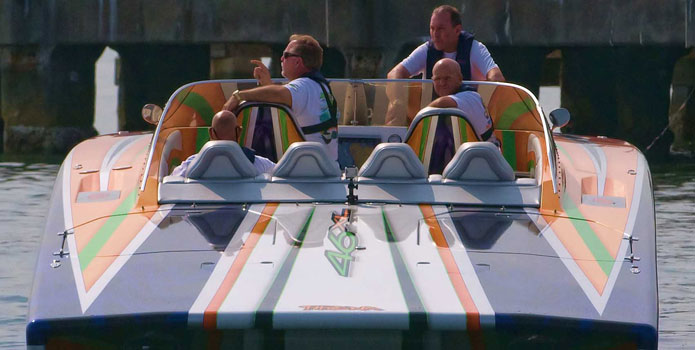Tres Martin’s Safety Corner: How Fast Is Too Fast?
With the 2014 poker run season kicking off in a few weeks with the Florida Powerboat Club’s Miami Boat Show Poker Run, I thought it was time to ask renowned driving instructor Tres Martin, the founder of the Performance Boat School that bears his name, what has become the multi-million-dollar question.
How fast is too fast?
Martin broke his answers into three categories. Here’s what he had to say.
How fast is too fast? Knowing and respecting the answer for you and your boat before you head out could save your life. Photo courtesy/copyright Jay Nichols/Naples Image.
For the boat: “Some boats can’t go fast without handling problems because of design or hydrodynamic issues. I have run big boats that didn’t handle well at high speed, and small boats that ran really well at high speed. For a lot of boats out there right now, 150 mph is too fast.”
For the conditions: “What I tell people in boat school is that there is never a ‘perfect’ day to run your boat to its limit. Unless you get up and on the water at 6 a.m., there is always going to be someone else on the waterway, and even getting out there early is no guarantee. You need to be aware of the water conditions, including the traffic at all times, but it’s especially important when you’re running fast. If you’re running 150 mph and you hit one rogue wake from a yacht, it could be catastrophic. Are you leaving enough area around you for the speed you’re running? Are you constantly scanning the area around for potential hazards such as yachts creating wakes? Have you been watching your GPS or reading charts for potential shallow areas ahead? It’s all part of assessing conditions, and they often dictate how fast is too fast.”
For the driver: “I think a lot of the guys running over 150 mph are going too fast. At that speed, you really don’t have the time or distance to recover—you really can be trying to maneuver the boat at that speed. At that speed, your boat still has a lot of mass but it has a small footprint in the water. You’re not going to make it stop and it’s not going to respond or turn very well. People have no idea how fast they’re really going—I hear this in boat school all the time—because they’re so protected from the elements in today’s performance boats. They’ll look at the speedometer and say, ‘I had no idea we were going this fast.’ I hear that all the time.”
“Going over 100 mph without much seat time is not a good idea. But seat time is tricky. A guy might have a lot of seat time but poor skills to begin with. People have to go through the proper training cycles, which is why during boat school we often put restrictions on the speeds we allow our students to run. We’re not trying to ‘scare’ people, but in our course we do talk about all the things that can and do go wrong. We’re not necessarily trying to instill fear, but we are trying to get them to understand and respect what they’re doing. We want people to understand that they can really get hurt in these vessels if they don’t learn to handle them properly and responsibly, and always use good judgment.
“Food for thought: What happens to most people when they get in a car accident on the interstate at 55 to 60 mph? Generally, they end up in the hospital. Now you’re in a boat going three times that speed, and if you have an accident you’re not strapped in and you don’t have an air bag. The results are going to be catastrophic. That, too, is a big part of understanding how fast is too fast.”
Related Story


